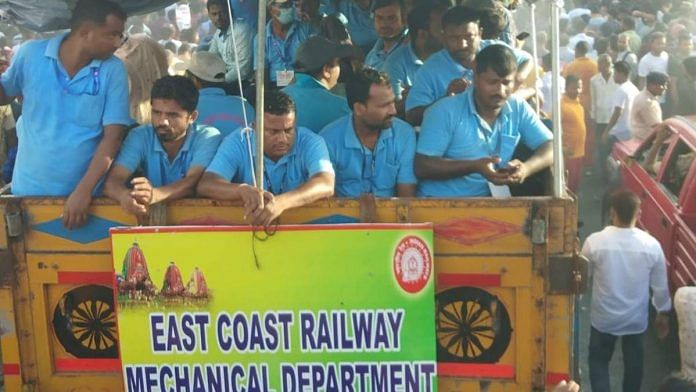Puri: The Indian Railways is known for being the lifeline of India, reportedly carrying over 1.3 crore passengers daily, but few are aware of its decades-old role in ensuring the smooth run of chariots during Odisha’s popular Jagannath Rath Yatra festival.
Since 1964, the mechanical department and staff of the East Coast Railway have been involved in positioning and moving the three chariots of the yatra in line on the procession route via the use of special screw jacks.
During the ceremonial procession, the three Hindu deities of Jagannath, Balabhadra and Subhadra are hauled in huge, decorated chariots from Puri’s Jagannath temple to Gundicha temple, and back.
According to officials from the East Coast Railway, a team of about 40 accompanies the procession with equipment to pull the three chariots in line and remove any obstacle from their path. They are also responsible for inspection, alignment, positioning and maintaining proper gap between the chariots.
“The wood chariots don’t have modern features like differential steering (method to orient/steer a vehicle on wheels or tracks). We use traversing screw jacks that are controlled by about 40 people to pull the chariots in line,” Aditya Sethi, Executive Operations Manager of the Indian Railways, told ThePrint.
“These chariots shouldn’t move backwards and it’s our responsibility to prevent that,” he added.
The 40-member railways’ team comprises technicians, one mechanical engineer, one senior section engineer and two assistant section engineers.
Ravindranath Panigrahi, senior section engineer in the East Coast Railways, said he has been performing this job since 1987 and has been quite devoted to it.
He told ThePrint that over the 11 days of the procession, the 40-member team remains on a strictly vegetarian diet and “prepares for a month in advance to get the screw jacks ready and devise strategies to make the chariots go straight”.
“Every year this work has to happen. God never leaves us. It is a difficult task but nothing seems hard when one is doing God’s work,” he added.
According to Panigrahi, the railways’ service to the Jagannath Yatra was offered voluntarily in 1964 after a railway personnel witnessed an incident in which one of the chariots got entangled with an electrical pole.
Also Read: Hi-tech machines, 9,000+ workforce — inside Integral Coach Factory making Vande Bharat trains
‘Harmonious’ work
East Coast Railway officials said the chariots used in the yatra are still made in the traditional way, with simple wood material, and lack the system that can help them go straight — which is where the mechanical department of the railways steps in.
The officials added that all the screw jacks are placed at different places under a chariot and operated simultaneously for lifting and shifting of the chariots.
Explaining the process, Sethi used the example of the Jagannath chariot, which has 16 wheels and eight axles (central shaft for rotating wheels).
“The screw jacks are placed not below the wheel but below the axle and thus, the 16 wheels are lifted two inches above the ground. There is a spindle that is moved by a ratchet (mechanical device) that brings the chariot in the right direction as instructed. Since the wheels are not touching the ground at the point, there is no friction during movement,” Sethi said.
Railway officials pointed out that the job required coordination and balance among the 40-member team, without which there could be “serious consequences” for people pulling the chariots in different directions.
“This ‘harmonious’ work comes in handy especially where there is a breakdown in an axle or wheel that requires urgent correction,” one of the officials told ThePrint.
“Such issues are common when there is difficult movement during the yatra, like when it has to move 180 degrees from Gundicha temple,” said the official.
The Jagannath Yatra holds religious significance in the country and attracts lakhs of tourists every year. The procession will begin on 20 June this year and, according to railway officials, 75 per cent of preparations are already done.
(Edited by Nida Fatima Siddiqui)
Also Read: Vande Bharat Express is changing Indian Railways. Now Indians need to do their bit



